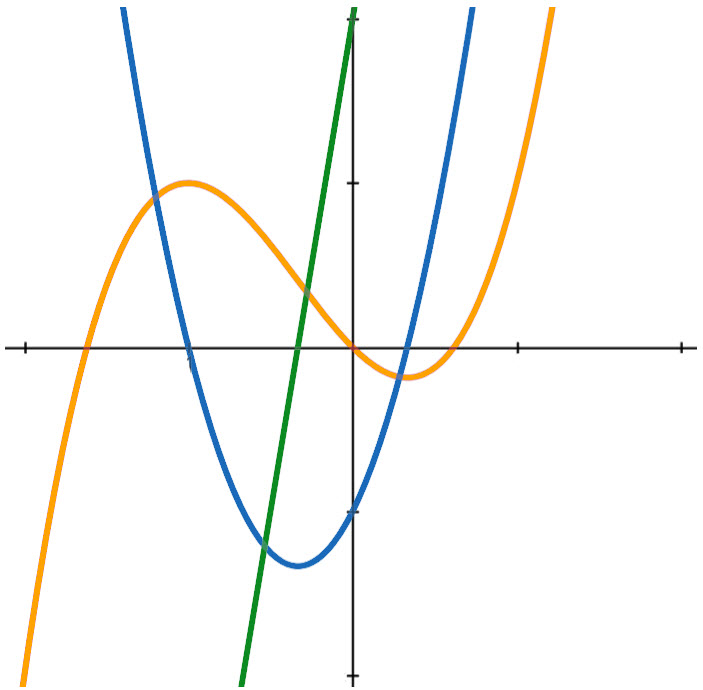Andymath.com features free videos, notes, and practice problems with answers! Printable pages make math easy. Are you ready to be a mathmagician?
Find \(\frac{dy}{dx}\) by implicit differentiation
\(\textbf{1)}\) \(x^2+y^2=25\)
\(\textbf{2)}\) \(x^2y-xy=10\)
\(\textbf{3)}\) \(\sin x+\cos y=.5 \)
\(\textbf{4)}\) \(\displaystyle \frac{1}{x}+\frac{1}{y}=10\)
\(\textbf{5)}\) \(x^5-y^4=20\)
\(\textbf{6)}\) \(y-x+xy=8\)
\(\textbf{7)}\) \(x^2-xy=25\)
\(\textbf{8)}\) \(xy+y=x+7\)
\(\textbf{10)}\) \(\text{Find the slope of } x^3+y^2x=-4xy \text{ at } \, (3,-1)\)
\(\textbf{11)}\) \(\text{Find the slope of } \cos x+\sin y=1 \text{ at } \, (0, 0)\)
\(\textbf{12)}\) \(\text{Find the slope of } \left(x^2+y^2\right)^2 = 4x^2y \text{ at } \, (1, 1)\)
See Related Pages\(\)
\(\bullet\text{Implicit Differentiation Calculator }\)
\(\,\,\,\,\,\,\,\,\text{(Symbolab.com)}\)
\(\bullet\text{ Calculus Homepage}\)
\(\,\,\,\,\,\,\,\,\text{All the Best Topics…}\)
\(\bullet\text{ Definition of Derivative}\)
\(\,\,\,\,\,\,\,\, \displaystyle \lim_{\Delta x\to 0} \frac{f(x+ \Delta x)-f(x)}{\Delta x} \)
\(\bullet\text{ Equation of the Tangent Line}\)
\(\,\,\,\,\,\,\,\,f(x)=x^3+3x^2−x \text{ at the point } (2,18)\)
\(\bullet\text{ Derivatives- Constant Rule}\)
\(\,\,\,\,\,\,\,\,\displaystyle\frac{d}{dx}(c)=0\)
\(\bullet\text{ Derivatives- Power Rule}\)
\(\,\,\,\,\,\,\,\,\displaystyle\frac{d}{dx}(x^n)=nx^{n-1}\)
\(\bullet\text{ Derivatives- Constant Multiple Rule}\)
\(\,\,\,\,\,\,\,\,\displaystyle\frac{d}{dx}(cf(x))=cf'(x)\)
\(\bullet\text{ Derivatives- Sum and Difference Rules}\)
\(\,\,\,\,\,\,\,\,\displaystyle\frac{d}{dx}[f(x) \pm g(x)]=f'(x) \pm g'(x)\)
\(\bullet\text{ Derivatives- Sin and Cos}\)
\(\,\,\,\,\,\,\,\,\displaystyle\frac{d}{dx}sin(x)=cos(x)\)
\(\bullet\text{ Derivatives- Product Rule}\)
\(\,\,\,\,\,\,\,\,\displaystyle\frac{d}{dx}[f(x) \cdot g(x)]=f(x) \cdot g'(x)+f'(x) \cdot g(x)\)
\(\bullet\text{ Derivatives- Quotient Rule}\)
\(\,\,\,\,\,\,\,\,\displaystyle\frac{d}{dx}\left[\displaystyle\frac{f(x)}{g(x)}\right]=\displaystyle\frac{g(x) \cdot f'(x)-f(x) \cdot g'(x)}{[g(x)]^2}\)
\(\bullet\text{ Derivatives- Chain Rule}\)
\(\,\,\,\,\,\,\,\,\displaystyle\frac{d}{dx}[f(g(x))]= f'(g(x)) \cdot g'(x)\)
\(\bullet\text{ Derivatives- ln(x)}\)
\(\,\,\,\,\,\,\,\,\displaystyle\frac{d}{dx}[ln(x)]= \displaystyle \frac{1}{x}\)
\(\bullet\text{ Horizontal Tangent Line}\)
\(\,\,\,\,\,\,\,\,\)
\(\bullet\text{ Mean Value Theorem}\)
\(\,\,\,\,\,\,\,\,\)
\(\bullet\text{ Related Rates}\)
\(\,\,\,\,\,\,\,\,\)
\(\bullet\text{ Increasing and Decreasing Intervals}\)
\(\,\,\,\,\,\,\,\,\)
\(\bullet\text{ Intervals of concave up and down}\)
\(\,\,\,\,\,\,\,\,\)
\(\bullet\text{ Inflection Points}\)
\(\,\,\,\,\,\,\,\,\)
\(\bullet\text{ Graph of f(x), f'(x) and f”(x)}\)
\(\,\,\,\,\,\,\,\,\)
\(\bullet\text{ Newton’s Method}\)
\(\,\,\,\,\,\,\,\,x_{n+1}=x_n – \displaystyle \frac{f(x_n)}{f'(x_n)}\)
In Summary
Implicit differentiation is a mathematical technique used to find the derivative of an equation that cannot be solved for one of its variables in terms of the other. This is in contrast to explicit differentiation, where the derivative can be found by simply taking the derivative of one variable with respect to the other. In order to understand implicit differentiation, it is important to have a strong foundation in basic differentiation techniques and the chain rule. Implicit differentiation relies on the chain rule to find the derivative of an equation that cannot be solved for one variable in terms of the other.
One reason why we learn about implicit differentiation is that it allows us to find the derivative of functions that cannot be expressed in a simple algebraic form. This can be useful in a variety of applications, including optimization problems and modeling real-world phenomena.
Implicit differentiation is covered in calculus courses.
A common mistake made when using implicit differentiation is forgetting to apply the chain rule.
Implicit differentiation can be used to find the equation of a tangent line to a curve. By setting the derivative of the equation equal to the slope of the tangent line, and solving for the y-intercept, we can find the equation of the tangent line.
Math topics that use Implicit Differentiation
Equation of a tangent line to a curve: Implicit differentiation can be used to find the equation of a tangent line to a curve that is given implicitly. For example, given the curve defined by the equation \(x^2 + y^2 = 25\), you can use implicit differentiation to find the equation of the tangent line at any point on the curve.
Extrema of curves: Implicit differentiation can be used to find the local extrema (maximum and minimum points) of a curve that is defined implicitly.
Points of inflection: Implicit differentiation can be used to find points of inflection on a curve that is defined implicitly. A point of inflection is a point where the curve changes from being concave upward to concave downward, or vice versa.
Equations of normal lines: Implicit differentiation can be used to find the equations of normal lines to a curve that is defined implicitly. A normal line is a line that is perpendicular to the tangent line at a given point on the curve. You set the slope of the tangent line equal to the negative reciprocal of the derivative value. For example, given the curve defined by the equation \(x^2 + y^2 = 25\), you can use implicit differentiation to find the equation of the normal line at any point on the curve.
About Andymath.com
Andymath.com is a free math website with the mission of helping students, teachers and tutors find helpful notes, useful sample problems with answers including step by step solutions, and other related materials to supplement classroom learning. If you have any requests for additional content, please contact Andy at tutoring@andymath.com. He will promptly add the content.
Topics cover Elementary Math, Middle School, Algebra, Geometry, Algebra 2/Pre-calculus/Trig, Calculus and Probability/Statistics. In the future, I hope to add Physics and Linear Algebra content.
Visit me on Youtube, Tiktok, Instagram and Facebook. Andymath content has a unique approach to presenting mathematics. The clear explanations, strong visuals mixed with dry humor regularly get millions of views. We are open to collaborations of all types, please contact Andy at tutoring@andymath.com for all enquiries. To offer financial support, visit my Patreon page. Let’s help students understand the math way of thinking!
Thank you for visiting. How exciting!